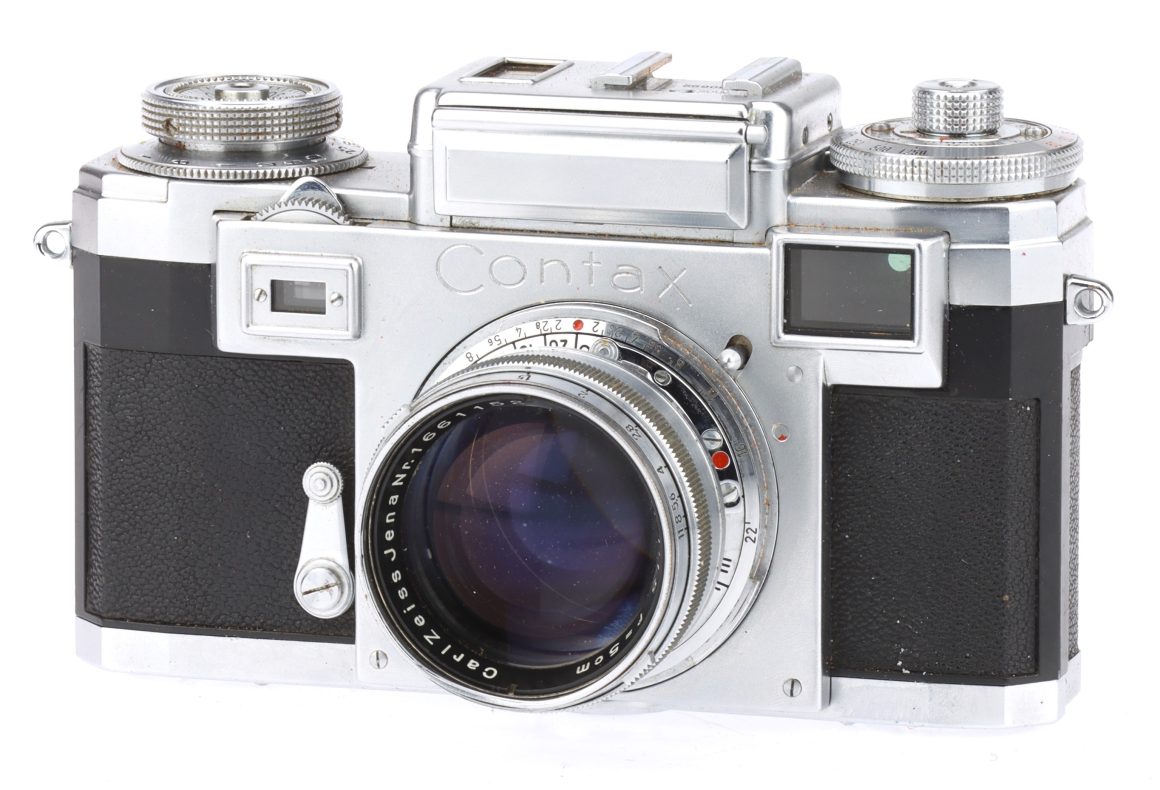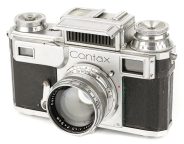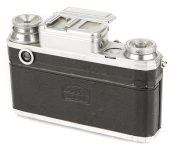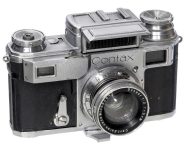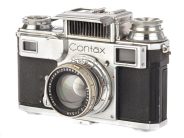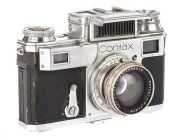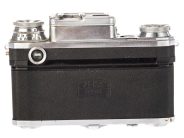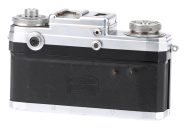Contax III
35mm MF film rangefinder camera • Discontinued
- Announced:
- · 1936
- Production status:
- ● Discontinued
- Country of design:
- · German Reich
- System:
- · Contax (1932)
Specification
| Format: | |
| 35mm full frame | |
Film type: | 135 cartridge-loaded film |
| Contax [34.85mm] | |
| Shutter: | |
Type: | Focal-plane |
Model: | Mechanical |
Speeds: | 1/2 - 1/1250 + B, T |
| Exposure: | |
Exposure metering: | Through the separate window |
Exposure modes: | Manual |
| Rangefinder and Viewfinder: | |
Rangefinder: | Built-in, combined with viewfinder |
Viewfinder: | Built-in, combined with rangefinder |
Finder magnification: | 0.75x |
Actual rangefinder base: | 90mm |
Effective rangefinder base: | 67.5mm |
Bright-line frames: | - |
Parallax compensation: | - |
| Physical characteristics: | |
Weight: | <No data> |
Dimensions: | <No data> |
Manufacturer description #1
CONTAX is now available in three models. Basically, the three models offer the same fundamental photographic possibilities and accommodate practically the same range of lenses and accessories. They differ, however, in the following respects.
The CONTAX I is finished in nickel and black enamel, whereas the CONTAX II and III are finished in chromium, partly dull and partly bright.
In CONTAX II and III (chromium) the range-finder and view-finder are combined in one opening, giving speedier manipulation and a larger image. The winding knob is situated on top of the camera with the shutter release conveniently located in the center of the knob. The top speed has been increased from 1/1000th to 1/1250th of a second. The whole scale of shutter speeds is always visible. Adjustments can be made both before and after winding the shutter, same as with CONTAX I. A self-timing device permits delayed action release for taking your own picture; the release takes place automatically after a delay of approximately twelve seconds. The same mechanism also permits an automatic exposure of one second.
CONTAX III has a built-in photoelectric exposure meter. In all other respects this model is built like CONTAX II.
Manufacturer description #2
Exactly similar in construction to Contax II, the Contax III also provides a built-in photo-electric exposure meter. It is thus particularly suitable for colour photography, since correct exposure, very desirable throughout "miniature" work, is especially important when using colour films which allow hardly any exposure latitude. The Contax III built-in photo-electric exposure meter is extremely sensitive, and is so constructed that it embraces the same angle of view as the normal 2" taking lens, therefore it ensures an accuracy which cannot be equalled by an exposure meter used independently.
The exposure meter on the Contax III is controlled by a simple system of discs and it is suitable for use with both natural and artificial light. An indicator is set to the appropriate film speed, then a milled wheel, conveniently situated under the rewinding knob, is turned until the pointer in the exposure meter window is brought opposite an index mark. The correct exposure time for any aperture can then be read off.
From the British Journal Photographic Almanac (1937)
As a fitting completion to the Contax series of miniature cameras the Contax Model III has now been produced. This new model is in all ways similar to its forerunner, with the single exception that, in addition, it has built into it a photo-electric exposure meter. The built-in exposure meter of the Contax III is connected with the large knob seen on the right of the camera and by means of this it is possible to adjust the needle of the meter to the index mark, or to one of the factors 2, 5, 10, or 20, which must be used if the light is not sufficiently strong to give a reading on the main mark. The rest of the knob is in the form of a calculator which enables the exposure to be read off for any stop and film speed. The cell itself is protected in front, when not in use, by a hinged flap which springs up at a touch, revealing a series of glass vanes so devised as to restrict the angle of field of the cell to that of the 5 cm. camera lens. The flap then acts as a sky shade. The topmost part of the calculator knob is the rewinder whicih it is necessary to use with cassettes or film in daylight-loading cartrdges. We understand that it will in the near future be possible to convert the Contax II into the model III, but for this purpose it will be necessary to return the camera to the Zeiss-Ikon works. The prices of the Contax III range, according to the optical equipment, from £53 to £78 5s. 0d.
Similar cameras (8)
| Model | Shutter | Metering | Modes | Year |
|---|---|---|---|---|
| Kiev-4 akaКиев-4 |
M, 1/1250 | Window | M | 1957 ● |
| Kiev-4A akaКиев-4А |
M, 1/1250 | -- | M | 1958 ● |
| Kiev-4AM akaКиев-4АМ |
M, 1/1000 | -- | M | 1980 ● |
| Kiev-4M akaКиев-4М |
M, 1/1000 | Window | M | 1976 ● |
| Kiev-5 akaКиев-5 |
M, 1/1000 | Window | M | 1968 ● |
| Kiev-III[A] akaКиев-III[А] |
M, 1/1250 | Window | M | 1952 ● |
| Kiev-II[A] akaКиев-II[А] |
M, 1/1250 | -- | M | 1947 ● |
| VTSVS akaВТСВС |
M, 1/500 | -- | M | 1949 ● |
